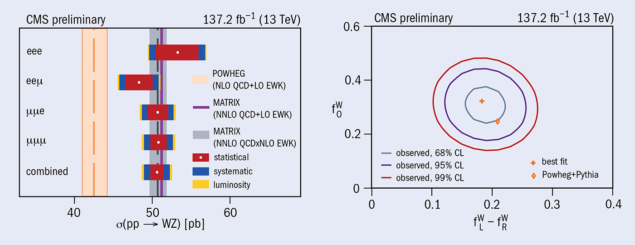A report from the CMS experiment

At the collision energies of the LHC, diboson processes have relatively high production cross sections and often produce relatively clean final states with two or more charged leptons. Consequently, multilepton final states resulting from diboson processes are powerful signatures to study the properties of the electroweak sector of the Standard Model. In particular, WZ production is sensitive to the strength of the triple gauge coupling that characterises the WWZ vertex, which derives from the non-Abelian nature of the electroweak sector. Additionally, as the Higgs mechanism is responsible for the appearance of longitudinally polarised gauge bosons, studying W and Z boson polarisation indirectly probes the validity of the Higgs mechanism.
The results include the first observation at any experiment of longitudinally polarised W bosons in diboson production
A recent result from the CMS collaboration uses the full power of the data taken during Run 2 of the LHC to learn as much as possible from WZ production in the decay channels involving three charged leptons (electrons or muons). The results include the first observation at any experiment of longitudinally polarised W bosons in diboson production.
Reconstruction and event selection were optimised to reduce contributions from processes with “non-isolated” electrons and muons produced in hadron decays – traditionally one of the primary sources of experimental uncertainty in such measurements. The total production cross section for WZ production was measured with a simultaneous fit to the signal-enriched region and three different control regions. This elaborate fitting scheme paid off, as the final result has a relative uncertainty of 4%, down from the 6% obtained in past iterations of the measurement. The results are all consistent with state-of-the-art theoretical predictions (figure 1, left).
A highlight of the analysis is the study of the polarisation of both the W and the Z bosons in the helicity frame, using missing transverse energy as a proxy for the transverse momentum of the neutrino in the W decay. This choice, coupled with the precisely measured four-momenta of the three leptons and the requirement that W boson be on-shell, allows both the W and Z momenta to be fully reconstructed. The angle between the W (Z) boson and the (negatively) charged lepton originating from its decay is then computed. The resulting distributions are fitted to extract the polarisation fractions fR, fL, and fo, which correspond to the proportion of bosons in the left, right and longitudinally polarised states in WZ production.
The measured polarisation fractions are consistent within 1σ with the Standard Model predictions (figure 1, right), in accordance with our knowledge of the electroweak spontaneous symmetry breaking mechanism. The significance for the presence of longitudinally polarised vector bosons is measured to be 5.6σ for the W boson and well beyond 5σ for Z-boson production. These new studies pave the way for future measurements of doubly polarised diboson cross sections, including the challenging doubly longitudinal polarisation mode in WW, WZ or ZZ production.
Further reading
CMS Collab. 2021 CMS-PAS-SMP-20-014.







